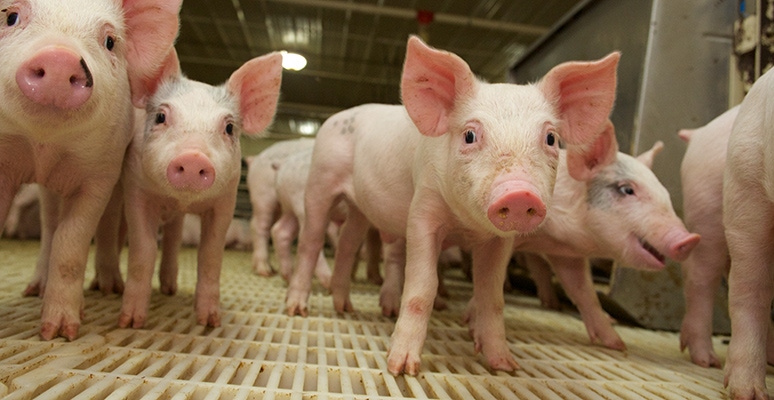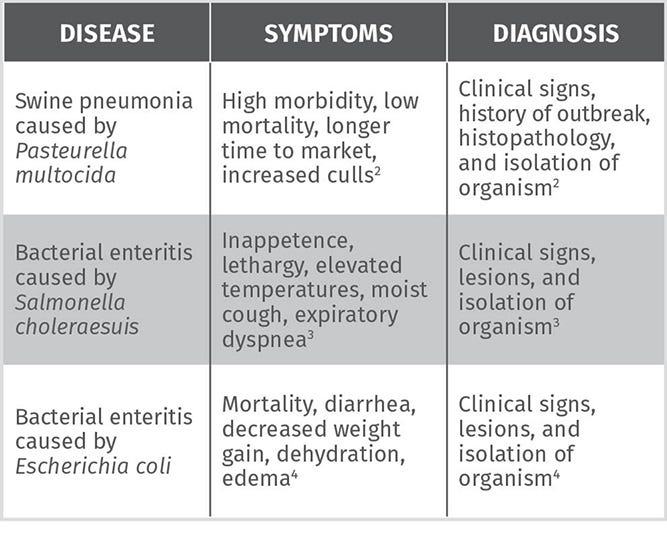Even on the most well-managed farms, seasonal changes can increase the impact of disease on your operation.
October 15, 2017

Sponsored Content
While swine pneumonia and bacterial enteritis may be subclinical at times, they still limit pig performance and profitability. As production moves into the fall and winter months, subclinical diseases may become clinical with increased stress due to environmental changes.
“During times of transition, when labeled pathogens are present, it’s more effective for producers to take a proactive approach by using an in-feed antibiotic than it is to have to scramble and treat a disease that has already gained a foothold,” says Dr. Kevin Eggers, DVM, Elanco Animal Health.
The combination of Denagard® 10 premix + CTC (chlortetracycline):
Controls swine dysentery associated with Brachyspira hyodysenteriae susceptible to tiamulin
Treats swine bacterial enteritis caused by Escherichia coli and Salmonella choleraesuis sensitive to chlortetracycline
Treats pneumonia caused by Pasteurella multocida sensitive to chlortetracycline
Using Denagard alone does not require a Veterinary Feed Directive (VFD). Using Denagard + CTC does require a VFD.
“Together, Denagard and CTC target on-label pathogens, inhibiting protein synthesis, by working at the ribosomal level,” explains Eggers. “But because their binding sites are different, the two modes of action have a larger spectrum of control over certain gram-negative bacteria when fed separately or individually.”
To demonstrate the efficacy of different antibiotic feeding programs, a study was conducted using a commercial population of approximately 2,250 nursery pigs with a known history of swine pneumonia and bacterial enteritis.1
Confirmation of the disease-causing bacterial agents (Pasteurella multocida and Escherichia coli) was determined via laboratory diagnostics. The table below provides additional information about typical symptoms associated with these diseases.

The study included three treatments:
Treatment 1 = Negative control for 14 days
Treatment 2 = 400 grams/ton chlortetracycline + Denagard 35 grams/ton for 14 days
Treatment 3 = 400 grams/ton oxytetracycline** + Mecadox®** 25 grams/ton for 14 days
Live performance from start to day 14: 30-pen study

By treating Escherichia coli and Pasteurella multocida, Denagard + CTC improves:
Average daily gain and feed intake when compared to untreated controls
Feed efficiency when compared to feeding Mecadox + OTC (oxytetracycline) and control diets
“The study found that by treating pneumonia and enteritis caused by Pasteurella multocida and Escherichia coli, pigs that received in-feed antibiotics had restored appetites and improved growth,” says Eggers. “A healthier pig is obviously better equipped to handle the disease challenges that come with the changing seasons.”
The labels contain complete use information, including cautions and warnings. Always read, understand and follow the label and use directions.
INDICATIONS: DENAGARD 10 PREMIX
For control of swine dysentery associated with Brachyspira hyodysenteriae susceptible to tiamulin:
Feed 35 g/ton
Feed continuously as sole ration
2-day withdrawal
For treatment of swine dysentery associated with Brachyspira hyodysenteriae susceptible to tiamulin:
Feed 200 g/ton
Feed for 14-days for treatment
7-day withdrawal
For control of ileitis associated with Lawsonia intracellularis susceptible to tiamulin:
Feed 35 g/ton
Feed for not less than 10 days
2-day withdrawal
INDICATIONS: DENAGARD + CTC
For the control of swine dysentery associated with Brachyspira hyodysenteriae susceptible to tiamulin and for treatment of swine bacterial enteritis caused by Escherichia coli and Salmonella choleraesuis sensitive to chlortetracycline and treatment of bacterial pneumonia caused by Pasteurella multocida sensitive to chlortetracycline:
35 g/ton of Denagard + 400 g/ton (10 mg/lb body weight in daily divided doses) CTC
Feed for 14 days
2-day withdrawal
Using Denagard alone does not require a Veterinary Feed Directive (VFD). Using Denagard + CTC does require a VFD.
CAUTION: Federal law restricts medicated feed containing this veterinary feed directive (VFD) drug to use by or on the order of a licensed veterinarian.
IMPORTANT SAFETY INFORMATION
Swine being treated with Denagard (tiamulin) should not have access to feeds containing polyether ionophores (e.g. lasalocid, monensin, narasin, salinomycin and semduramicin) as adverse reactions may occur.
If signs of toxicity occur, discontinue use.
Withdraw 7 days before slaughter at 200 g/ton and 2 days before slaughter at 35 g/ton.
Keep out of reach of children. Avoid contact with skin.
The effects of tiamulin on swine reproductive performance, pregnancy and lactation have not been determined.
INDICATIONS: DENAGARD LC
For treatment of swine dysentery associated with Brachyspira hyodysenteriae susceptible to tiamulin:
Utilize Denagard LC in drinking water at 3.5 mg/lb (60 ppm) for five days for treatment of SD associated with Brachyspira hyodysenteriae susceptible to tiamulin.
For treatment of swine pneumonia associated with Actinobacillus pleuropneumoniae susceptible to tiamulin:
Utilize Denagard LC in drinking water at 10.5 mg/lb (180 ppm) for five consecutive days for treatment of swine pneumonia due to Actinobacillus pleuropneumoniae susceptible to tiamulin.
IMPORTANT SAFETY INFORMATION
Swine being treated with Denagard (tiamulin) should not have access to feeds containing polyether ionophores (e.g., lasalocid, monensin, narasin, salinomycin and semduramicin) as adverse reactions may occur.
If signs of toxicity occur, discontinue use of medicated water and replace with clean, fresh water.
Withdraw medicated water 3 days before slaughter after treatment at 3.5 mg/lb and 7 days before slaughter following treatment at 10.5 mg/lb.
Keep out of reach of children. Avoid contact with skin.
For use in drinking water of swine only. Prepare fresh medicated water daily. The effects of tiamulin on swine reproductive performance, pregnancy and lactation have not been determined.
If no response to treatment is obtained within 5 days re-establish the diagnosis.
**INDICATIONS: MECADOX AND TERRAMYCIN®
Terramycin (oxytetracycline) premix for swine for the treatment of bacterial enteritis caused by E. coli and Salmonella choleraesuis susceptible to oxytetracycline. For the treatment of bacterial pneumonia caused by Pasteurella multocida susceptible to oxytetracycline.
Mecadox (carbadox) for increased rate of weight gain and improved feed efficiency.
1Elanco Animal Health. Data on file.
2Zimmerman, J., Karriker, L. et al. (2012). Pasteurellosis. Diseases of Swine. 10: 803, 806.
3Zimmerman, J., Karriker, L. et al. (2012). Bacterial diseases. Diseases of Swine. 10: 826-829.
4Zimmerman, J., Karriker, L. et al. (2012). Bacterial diseases. Diseases of Swine. 10: 728-739.
Denagard, Elanco and the diagonal bar are trademarks of Eli Lilly and Company or its affiliates.
© 2017 Eli Lilly and Company or its affiliates.
All other products are the property of their respective owners.
Elanco supports the use of shared class antibiotics for therapeutic uses while under the oversight of a veterinarian. More details on Elanco’s Antibiotic, Welfare and Sustainability Policies can be found on www.elanco.com/antimicrobialpolicy.
About the Author(s)
You May Also Like



